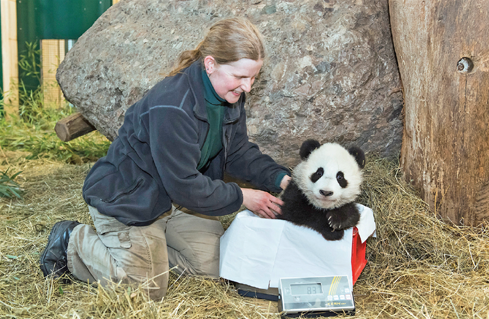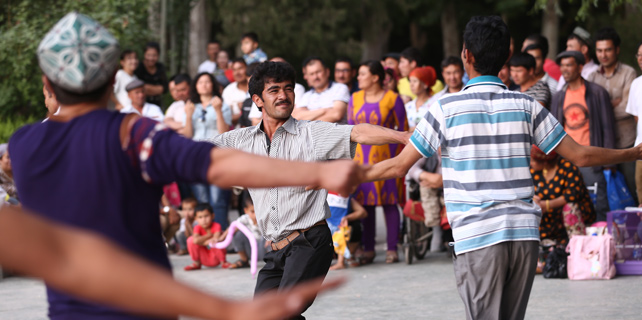Daily life a balance of eating, sleeping
|
 |
|
Renate Haider, a keeper at Schonbrunn Zoo in Vienna, Austria, has been minding giant pandas Yang Yang and Long Hui since 2003. SCHONBRUNN ZOO |
It's 7:30 in the morning, and pandas at Schonbrunn Zoo in Vienna, Austria, are starting their day.
The keepers take them to an outside enclosure for breakfast while they clean the interior and stock it with fresh bamboo.
"Cleaning out the panda enclosures is hard work, but it's great fun as the pandas have to be moved around," says Renate Haider, a keeper who has been minding Yang Yang and Long Hui since 2003.
"Yang Yang enjoys taking a nap around noon, often between 11 am and 1 pm," Haider says. "After the nap, another portion of bamboo waits outdoors. About three times a week we perform training with the pandas, based on positive reinforcement."
In the training sessions, the animals are confronted with extra tasks for a few minutes, during which health checks can be carried out stress-free and without anesthetics, Haider says.
Panda experts say the bears can spend as long as 14 hours a day eating, since they consume at least 12 to 38 kilograms of food daily, including tender bamboo stems, shoots and leaves. Because bamboo has few calories, pandas maximize its value by sleeping much of the day.
They alternate their activities between sleeping and eating, Haider says. "Yang Yang eats approximately 30kg of bamboo daily, but the amount varies a lot. Sometimes she only likes to eat about 10 kg, depending on the season."
She added: "Our pandas also get a special cake made of bamboo flour, rice flour, cornflour, eggs and oat flakes. As a special treat, they sometimes receive sweet potatoes or carrots."
Yang Yang was born on Aug 10, 2013. She arrived at Schonbrunn in May 2013 with her male partner, Long Hui, who died from a malignant tumor of the bile ducts in December. The average life span of captive pandas is 25 to 30 years.
The pair successfully bred Fu Long, Fu Hu and Fu Bao in 2007, 2010, and 2013, respectively.
Haider was part of the transfer team that sent Fu Hu and Fu Bao to their new home when they turned 2, an arrangement agreed upon by contract.
"Different from Vienna, a huge number of pandas are living at the panda base in Chengdu," Haider says. "It was a wonderful experience to see all their different personalities and behaviors."
In August 2016, twins Fu Feng and Fu Ban were born. They are being raised by Yang Yang without the help of keepers, the first time a female panda in captivity has raised twins without assistance, according to Schonbrunn Zoo.
"Yang Yang enjoys playing with her twins, as well as hugging and cleaning them. Fu Feng and Fu Ban also love to climb the highest trees in the enclosure," Haider says.
Giant pandas are self-indulgent animals, and adults are kept separate most of the time. However, Yang Yang and Long Hui grew up together in a youth group at the Wolong reserve before moving to Vienna. Eveline Dungl, Schonbrunn's curator, is convinced that growing up together, and their age at the time of relocation, are of great importance to their breeding success.
















